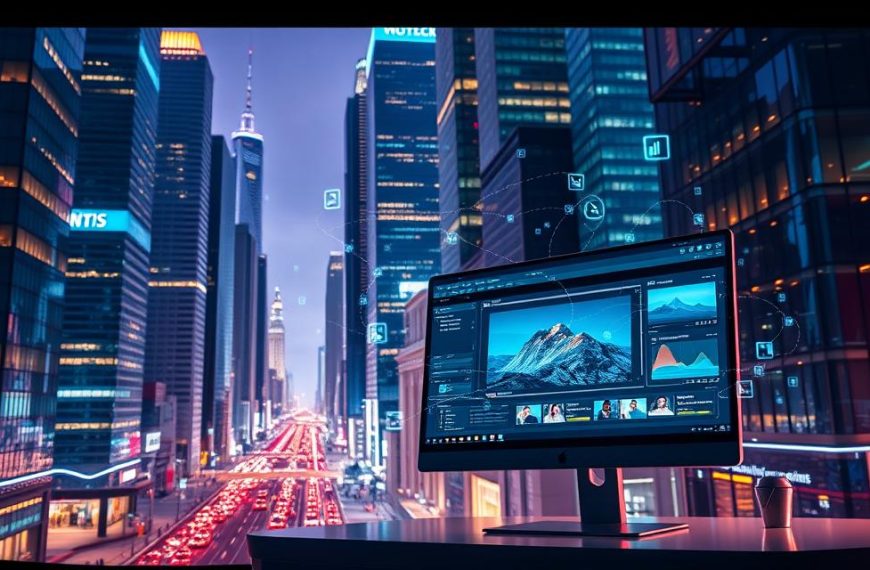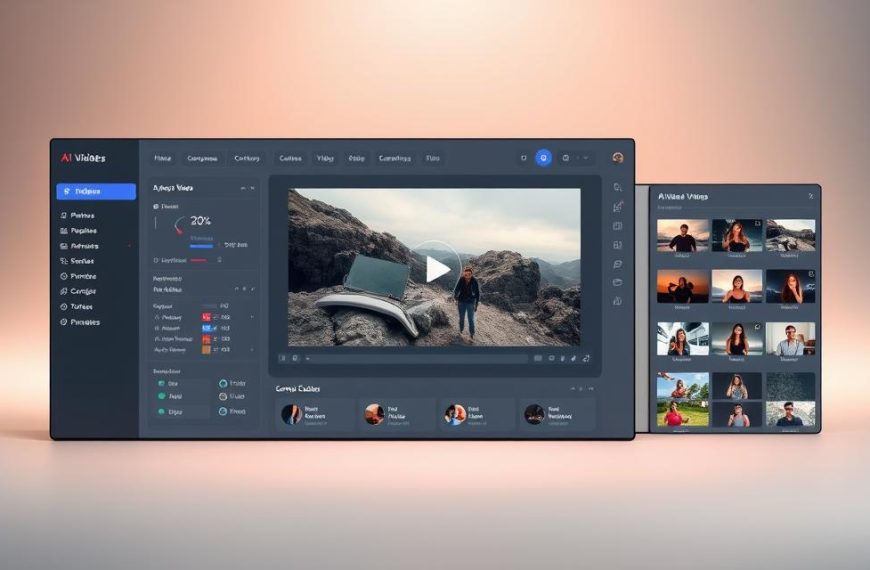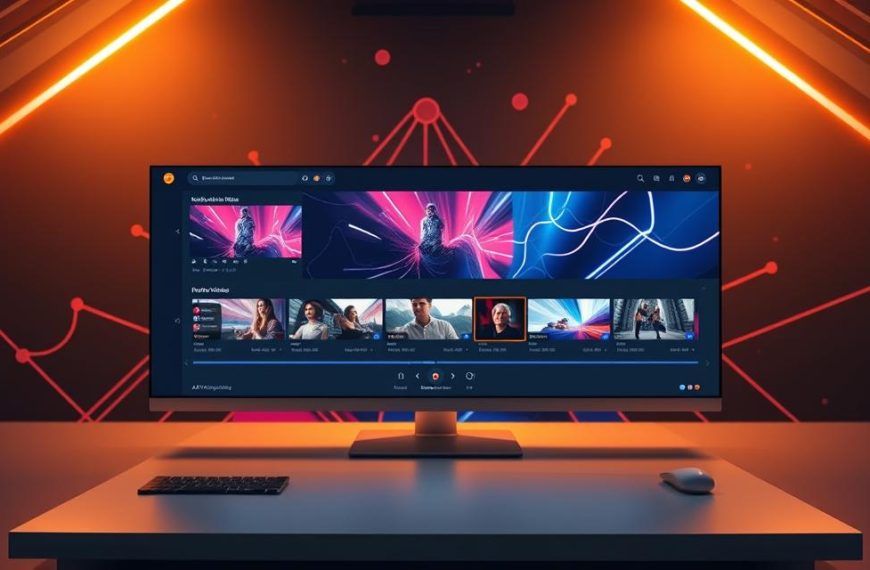In today’s digital world, we’re hit with too much video content. Long videos take up a lot of time. This is a big problem for both professionals and students.
Intelligent technology offers a great solution. It can look through hours of video and find the most important parts automatically.
A good video summariser changes how we watch videos. It spots key moments, understands important talks, and makes short summaries.
The top platforms make summaries that are both accurate and keep the original meaning. They let us quickly get the gist of complex topics without watching the whole video.
This tech is a big step forward in handling content. Picking the right video summariser can really change how you work and learn.
The Growing Need for Video Summarisation
The digital world has changed a lot, with video leading the way in sharing and learning. This rapid growth means we need quick ways to summarise content. It’s about keeping up with the vast amount of videos out there.
Professionals in all fields struggle to watch long videos and stay productive. Watching full videos is no longer practical in today’s fast-paced world.
Why Lengthy Videos Are Problematic
Long videos are a big problem for today’s viewers. They take up too much time, which is hard for busy people. Many feel frustrated after spending hours on videos that don’t give them what they need.
There’s also the issue of too much information. It’s hard to find and remember important points in long videos. This makes them less useful for research and learning.
The issue goes beyond just wasting time. Research shows that people often stop watching videos before finding what they need. This shows a big gap between how long videos are and how interested viewers stay.
Key challenges include:
- Substantial time commitment that conflicts with busy schedules
- Difficulty identifying core concepts amidst extensive content
- Reduced information retention due to cognitive overload
- Inefficient content navigation for specific information retrieval
These problems hit many areas like education, corporate training, and professional growth. The need for AI summarisation is growing fast. Companies want to get the most out of learning without wasting time.
Many professionals are tired of watching videos that don’t help. They need smart tools to cut out the unnecessary. These tools should focus on the important stuff, saving time and effort.
How AI Powers Video Shortening and Summarisation
Artificial intelligence has changed how we deal with video content. It lets us shorten videos without losing important details. This is thanks to advanced algorithms and lots of computing power.
Natural Language Processing in Video Analysis
Natural Language Processing is key to understanding video speech. It turns audio into text, making it easy to search. This tech can handle different accents and sound qualities.
The system then looks at this text to find important topics and feelings. It gets the context by spotting patterns in conversations. This helps the AI pick out the most valuable parts of the speech.
Advanced NLP can also catch the tone and stress of words. This helps it focus on the most critical parts. This step is vital for making summaries that really capture the video’s message.
Machine Learning for Content Extraction
Machine learning takes video analysis further by learning from lots of data. These models are trained on hours of video, learning what’s important. They can spot patterns and rank content based on its significance.
The AI gives scores to frames and words based on their importance. It looks at things like how complex the visuals are and how relevant the topics are. This helps it find the most important parts automatically.
As these models learn more, they get better at making summaries that keep the video’s core message. They become more skilled at knowing what viewers find most interesting. This makes them great at shortening videos without losing the essence.
This mix of technologies can turn hours of video into short, meaningful summaries in just minutes. It’s a big step forward for managing and sharing video content in many fields.
Key Features to Look for in a Shorten AI Tool
The right video shortening AI has to be accurate, easy to use, and flexible. It’s important to pick a tool that meets your specific needs.
Accuracy in Summarisation
Any good video summarisation tool needs to be precise. It must accurately capture spoken words before shortening them.
Tools like Notta show off with 98.86% accuracy. This means the summary captures the video’s main points well.
For a YouTube summariser, getting the content right is key. It should focus on the main points and keep the context.
Ease of Use and Integration
A powerful AI tool is useless if it’s hard to use. Easy interfaces help users make summaries quickly, even if they’re not tech-savvy.
Tools that integrate well with your workflow are a big plus. Browser extensions, like Wordtune’s Chrome extension, make summarising fast and easy.
Think about how the tool fits into your current setup. Good integration with your tools makes your work smoother.
Customisation Options
Tools that let you adjust the output are more useful. You can make summaries fit different platforms and audiences.
Advanced options include using templates and changing formats. Some tools have special templates for different video types.
Look for tools that work with many languages if you need to work globally. The best YouTube summariser tools handle various languages well.
Having options for how to present your summary is also important. You can choose text, highlight reels, or condensed versions.
Top Shorten AI Tools for Video Content
The market has many AI tools for shortening videos. Each tool has its own strengths. You need to choose based on what you need most: accuracy, integration, or customisation.
Descript: Advanced Editing and Summarisation
Descript is known for its advanced editing suite. It’s great at transcription and lets you edit videos by changing the text. This makes content extraction very easy.
Key features include:
- Overdub function for voice cloning
- Multi-track editing capabilities
- Automatic filler word removal
Pricing starts at $15 monthly for individuals. Larger teams can get custom pricing.
Lumen5: AI-Driven Video Creation and Condensing
Lumen5 is great at making long videos shorter. It’s perfect for marketing teams needing quick promotional clips. It uses smart algorithms to find the most important parts.
Notable advantages:
- Brand kit customisation
- Extensive media library access
- Social media optimisation features
Basic plans start at $19 monthly. Business plans offer advanced analytics and team tools.
SummarizeBot: Quick Summaries for Various Formats
SummarizeBot works with many content types, not just videos. It’s great for organisations with different media needs. It uses advanced natural language processing for quick summaries.
Distinguishing characteristics:
- Multi-platform compatibility
- Real-time processing capabilities
- Blockchain-based security features
It offers pay-as-you-go credits and monthly plans. Large clients can ask for custom API integration.
Additional Notable Tools
There are other tools worth looking at for specific needs:
Notta is very accurate, over 98%. It’s best for legal and medical professionals needing exact records.
Wordtune is great for summarising YouTube videos. It’s a browser extension that works instantly.
Monica is easy to use with Chrome for research. It’s very helpful for students and academics.
Each tool has its own benefits for content extraction and summarisation. Think about your budget, needs, and integration before choosing the best one.
Use Cases for Shorten AI in Various Industries
Artificial intelligence video shortening tools are changing how we handle video content. They bring great value to many sectors, from education to business.
Education and E-Learning
Students and teachers greatly benefit from video summarisation. Long lectures are made easier to understand through smart shortening.
Studies show that shorter content helps us remember things better. AI tools spot the most critical parts of educational videos.
Platforms like Mindgrasp let students quickly check their study materials before tests. Teachers can also make shorter versions of their lessons for students to review.
Marketing and Social Media
Content creators use these tools to make short teasers from long videos. Social media likes short, catchy videos that grab attention.
Marketing teams use NLP video analysis to find the best parts of videos. This makes creating promotional content easier without manual editing.
It’s easier to compare video strategies by quickly summarising them. This saves a lot of time that would be spent watching full videos.
Corporate Training
Companies use video shortening to improve their training. Shorter training sessions make onboarding faster for employees.
Webinars and meetings can be turned into quick training materials for later. This keeps important info available without wasting time.
When employees get focused, summarised content, they remember more. Corporate trainers like how these tools keep the essence of the message while being brief.
The use of AI for video shortening is a big change in how we make and use content.
Challenges and Limitations of AI Video Shortening
AI video shortening tools are impressive but face big challenges. They struggle to keep content true to its original form. This is more obvious with complex or nuanced content that needs deep understanding.
Context Preservation Issues
Machine learning video systems have a big problem with keeping context. They often miss out on things like sarcasm or implied meaning. This can make summaries that are off the mark or even change the message.
These tools might also cut out important details that make content meaningful. For example, educational materials could lose essential explanations. Business presentations might miss out on persuasive elements.
Even top systems can make summaries that look right but don’t really get the content.
Handling Complex Visuals
AI tools find it hard to deal with videos full of visual information. Things like diagrams, charts, and fast scenes are tough for them. They mainly focus on what’s said, ignoring what’s shown.
Technical talks with lots of visuals often get lost in translation. The AI might get the words but miss the visuals that back them up. This leaves summaries that don’t fully get the message.
While machine learning video tech is getting better at visuals, it’s not there yet. It’s hard for AI to understand complex visual stories where pictures tell the tale.
The difference in how AI handles audio versus visuals is a big problem. It affects many types of content, from science to art, where pictures tell the story.
Conclusion
AI video shortening tools are a big step forward in managing content. They save a lot of time and make content easier to access in many fields. These tools turn long videos into short summaries, making them more fun and easy to watch.
When picking a tool, look for features like accurate transcription. This keeps the content’s meaning when it’s shortened. Also, think about how the tool fits your specific needs, how it works with other systems, and if you can change it to suit your needs.
As AI gets better, we’ll see even more advanced tools for shortening videos. These new tools will understand the context better and work smoothly with other systems. This will make AI video shortening a key part of how we handle digital content.


















